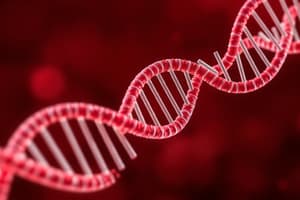Podcast
Questions and Answers
Qu'est-ce qui caractérise les exons dans l'ARN mature?
Qu'est-ce qui caractérise les exons dans l'ARN mature?
- Ils ne contiennent aucune partie codante.
- Ils sont excisés lors de l'épissage.
- Ils sont la principale composante de l'ADN.
- Ils représentent des régions traduites de l'ADN. (correct)
Quel aspect est principalement étudié dans le modèle de l'opéron Lac proposé par Jacob et Monod?
Quel aspect est principalement étudié dans le modèle de l'opéron Lac proposé par Jacob et Monod?
- La synthèse des protéines à partir d'ARN non-codants.
- La régulation de l'expression génique au niveau transcriptionnel. (correct)
- L'influence des ARN de transfert sur l'expression génique.
- La structure des gènes bactériens à travers l'ARN mature.
Quelle affirmation est incorrecte concernant les introns?
Quelle affirmation est incorrecte concernant les introns?
- Ils ne sont pas traduits en protéines.
- Ils peuvent influencer la régulation génique.
- Ils se retrouvent dans l'ARN mature. (correct)
- Ils sont excisés entre l'ARN primaire et l'ARN mature.
Qu'est-ce qui est vrai au sujet des ARN messagers codant pour des protéines?
Qu'est-ce qui est vrai au sujet des ARN messagers codant pour des protéines?
Quel est le rôle des boucles de rétroaction dans le contrôle de l'expression des gènes?
Quel est le rôle des boucles de rétroaction dans le contrôle de l'expression des gènes?
Qu'est-ce qui détermine l'emplacement du codon de début dans un gène?
Qu'est-ce qui détermine l'emplacement du codon de début dans un gène?
Quel modèle simpliste décrit le flux d'information génétique?
Quel modèle simpliste décrit le flux d'information génétique?
Quel est le rôle de l'enzyme aspartate kinase dans la levure?
Quel est le rôle de l'enzyme aspartate kinase dans la levure?
Quels sont les transcrits alternatifs déterminés par le gène HOM3?
Quels sont les transcrits alternatifs déterminés par le gène HOM3?
Quelle est la catégorie de transfert d'information considérée comme très invraisemblable?
Quelle est la catégorie de transfert d'information considérée comme très invraisemblable?
Quelle partie d'un gène représente la région codante?
Quelle partie d'un gène représente la région codante?
Quel type d'éléments peut être visualisé à l'aide du navigateur de génomes yeastgenomes.org?
Quel type d'éléments peut être visualisé à l'aide du navigateur de génomes yeastgenomes.org?
Quel aspect du dogme central souligne que la réverse transcription ne le réfute pas?
Quel aspect du dogme central souligne que la réverse transcription ne le réfute pas?
Quel est le rôle des facteurs transcriptionnels comme PAX6 dans l'activation de la transcription ?
Quel est le rôle des facteurs transcriptionnels comme PAX6 dans l'activation de la transcription ?
Quel mécanisme décrit la répression transcriptionnelle par un facteur inhibiteur ?
Quel mécanisme décrit la répression transcriptionnelle par un facteur inhibiteur ?
Dans quel tissu s'exprime spécifiquement l'hémoglobine ?
Dans quel tissu s'exprime spécifiquement l'hémoglobine ?
Quel type de données la base de données GTEx fournit-elle ?
Quel type de données la base de données GTEx fournit-elle ?
À quoi servent les gènes Hox dans le développement ?
À quoi servent les gènes Hox dans le développement ?
Quel est l'effet d'un facteur inhibiteur qui s'accroche à un activateur transcriptionnel ?
Quel est l'effet d'un facteur inhibiteur qui s'accroche à un activateur transcriptionnel ?
Quelle méthode est utilisée pour mesurer la quantification des ARN dans chaque tissu par le projet GTEX ?
Quelle méthode est utilisée pour mesurer la quantification des ARN dans chaque tissu par le projet GTEX ?
Quelle est l’expression de la myoglobine par rapport à ses tissus cibles ?
Quelle est l’expression de la myoglobine par rapport à ses tissus cibles ?
Flashcards
Epissage
Epissage
Processus qui modifie le pré-ARN en ARN mature en enlevant les introns et en reliant les exons.
Exons
Exons
Sections of DNA that remain in the mature RNA.
Introns
Introns
Sections of DNA that are removed during RNA processing.
Opéron
Opéron
Signup and view all the flashcards
ARN messager
ARN messager
Signup and view all the flashcards
Dogme central
Dogme central
Signup and view all the flashcards
Transcription
Transcription
Signup and view all the flashcards
Traduction
Traduction
Signup and view all the flashcards
Transcrits alternatifs
Transcrits alternatifs
Signup and view all the flashcards
Transcription Start Site (TSS)
Transcription Start Site (TSS)
Signup and view all the flashcards
Transcription Termination Site (TTS)
Transcription Termination Site (TTS)
Signup and view all the flashcards
Région codante
Région codante
Signup and view all the flashcards
Expression génétique
Expression génétique
Signup and view all the flashcards
Facteur transcriptionnel
Facteur transcriptionnel
Signup and view all the flashcards
Répression transcriptionnelle
Répression transcriptionnelle
Signup and view all the flashcards
Site d'initiation à la transcription
Site d'initiation à la transcription
Signup and view all the flashcards
Profil transcriptomique
Profil transcriptomique
Signup and view all the flashcards
GTEx
GTEx
Signup and view all the flashcards
RNA-Seq
RNA-Seq
Signup and view all the flashcards
Expression tissulaire
Expression tissulaire
Signup and view all the flashcards
Myoglobine
Myoglobine
Signup and view all the flashcards
Study Notes
Introduction to Bioinformatics 3
- DNA acts as the hereditary material, transmitting genetic information between generations.
- Replication, transcription, and translation are the key processes.
DNA/RNA/Protein Relations
- DNA → RNA (transcription): RNA polymerase creates RNA based on DNA template.
- RNA → Protein (translation): Ribosomes synthesize proteins based on RNA.
- Proteins and some RNAs carry out biological functions.
Gene Expression
- Genes encoding proteins have two stages: transcription (creating RNA from DNA) and translation (creating proteins from RNA).
- Some genes do not code for proteins.
Chromosomes and Heredity
- Chromosomes are the physical basis of heredity.
- In 1915, Thomas Hunt Morgan proposed the chromosomal theory of heredity.
- Humans have 23 pairs of chromosomes in somatic cells.
Karyotype
- A karyotype is a visual representation of a cell's chromosomes, arranged in pairs.
- Chromosomes are studied by microscopic techniques.
- Visualisations of human chromosomes are commonly used to assess for chromosomal abnormalities
- Modern investigation of karyotypes focus on sequencing.
DNA Structure and Function
- DNA is a double helix, with the sequence of its bases carrying the genetic information.
- The bases of DNA are cytosine(C), guanine(G), adenine(A), and thymine(T).
- Specific base pairing (A-T and C-G).
Gene Expression: DNA to RNA
- Transcription produces mRNA.
- Transcription is followed by translation to produce a protein from the mRNA.
Gene Code
- Specific combinations of three bases (codons) determine amino acid sequence.
- The genetic code is universal.
- There are 20 standard amino acids.
Genetic Processes
- The processes described involve DNA transcription, RNA translation, the role of mRNA, and the concept of a "central dogma"
Central Dogma of Molecular Biology
- DNA → RNA → Protein: genetic information flows from DNA to RNA to protein.
The Central Dogma
- Information flow generally proceeds in one direction—from DNA to RNA to protein—in most organisms.
- Exceptions exist as in some viruses.
- The flow of information is not always unidirectional.
Gene Structure
- Genes usually have a regulatory region, exons, and introns.
- Exons code for a protein; introns do not.
- Pre-mRNA includes both introns and exons.
Alternative Splicing
- A process where different combinations of exons are joined together to make different proteins from a single gene.
- This allows for multiple proteins from a single DNA sequence.
- In eukaryotes, the transcription of a given gene results in the production of multiple forms of the corresponding RNA molecule.
Gene Regulation
- Control of gene expression in various ways (example: transcription, splicing).
Genome Structure in Bacteria
- Operons: Multiple genes transcribed in clusters with shared regulatory elements.
- Regulatory elements control the transcription of the operon.
- Transcription and translation can be coupled in prokaryotic cells, whereas they occur separately in eukaryotic cells.
Genome Availability
- The availability of genome data has exploded (exponential growth).
- Recent advances in genome sequencing speed up the process of collecting genomics data.
- DNA sequencing technology advancements have made sequencing faster, more efficient, and more affordable.
Genome Annotations
- Processes to annotate genomic sequences.
- Methods used to map genes within a genome.
- Strategies for identifying protein-coding genes.
Protein-Protein Interactions; Interactome
- Proteins frequently interact.
- The collection of interactions in an organism is called the "interactome".
- Proteomics studies focus on proteins.
- Tools study protein-protein interaction networks to obtain a snapshot view of cellular processes.
Gene Expression in Different Tissues
- Expression patterns vary in different tissues.
- Techniques like "gene expression profiling" identify genes actively used in different tissues.
- Gene activity differs depending on the tissue in which they are located.
Studying That Suits You
Use AI to generate personalized quizzes and flashcards to suit your learning preferences.




